Structure and Spectral Luminescence Properties of (ZrO2)0.909(Y2O3)0.09(Eu2O3)0.001 Ceramics Synthesized by Uniaxial Compaction and Slip Casting
Abstract
1. Introduction
2. Materials and Methods
3. Results
4. Discussion
Author Contributions
Funding
Institutional Review Board Statement
Informed Consent Statement
Data Availability Statement
Acknowledgments
Conflicts of Interest
References
- Chen, Y.W.; Moussi, J.; Drury, J.L.; Wataha, J.C. Zirconia in biomedical applications. Expert Rev. Med. Devices 2016, 13, 945–963. [Google Scholar] [CrossRef] [PubMed]
- Peuchert, U.; Okano, Y.; Menke, Y.; Reichel, S.; Ikesue, A. Transparent cubic-ZrO2 ceramics for application as optical lenses. J. Eur. Ceram. Soc. 2009, 29, 283–291. [Google Scholar] [CrossRef]
- Mahato, N.; Banerjee, A.; Gupta, A.; Omar, S.; Balani, K. Progress in material selection for solid oxide fuel cell technology: A review. Prog. Mater. Sci. 2015, 72, 141–337. [Google Scholar] [CrossRef]
- Mansilla, Y.; Arce, M.; Oliver Gonzalez, C.; Troiani, H.; Serquis, A. Synthesis and characterization of ZrO2 and YSZ thin films. Mater. Today Proc. 2019, 14, 92–95. [Google Scholar] [CrossRef]
- Fergus, J.W. Electrolytes for solid oxide fuel cells. J. Power Sources 2006, 162, 30–40. [Google Scholar] [CrossRef]
- Dou, J.; Li, H.; Xu, L.; Zhang, L.; Wang, G. Preparation of YSZ solid electrolyte by slip casting and its properties. Rare Met. 2009, 28, 372–377. [Google Scholar] [CrossRef]
- Shukla, M.; Ghosh, S.; Dandapat, N.; Mandal, A.K.; Balla, V.K. Comparative Study on Conventional Sintering with Microwave Sintering and Vacuum Sintering of Y2O3-Al2O3-ZrO2 Ceramics. J. Mater. Sci. Chem. Eng. 2016, 4, 71–78. [Google Scholar]
- Vasile, B.S.; Andronescu, E.; Ghitulica, C.; Vasile, O.R.; Curechiu, L.; Scurtu, R.; Vasile, E.; Trusca, R.; Pall, L.; Aldica, V. Microstructure and electrical properties of zirconia and composite nanostructured ceramics sintered by different methods. Ceram. Int. 2013, 39, 2535–2543. [Google Scholar] [CrossRef]
- Oguntuyi, S.D.; Johnson, O.T.; Shongwe, M.B.; Jeje, S.O.; Rominiyi, A.L. The effects of sintering additives on the ceramic matrix composite of ZrO2: Microstructure, densification, and mechanical properties—A review. Adv. Appl. Ceram. 2021, 120, 319–335. [Google Scholar] [CrossRef]
- Anselmi-Tamburini, U.; Garay, J.E.; Munir, Z.A. Fast low-temperature consolidation of bulk nanometric ceramic materials. Scriptamaterialia 2006, 54, 823–828. [Google Scholar] [CrossRef]
- Binner, J.; Vaidhyanathan, B.; Wang, J.; Price, D.; Reading, M. Evidence for non-thermal microwave effects using single and multimode hybrid conventional microwave systems. J. Microw. Power Electromagn. Energy 2007, 42, 47–63. [Google Scholar] [CrossRef] [PubMed]
- Omar, S.; Najib, W.B.; Chen, W.; Bonanos, N. Electrical Conductivity of 10 mol% Sc2O3–1 mol% M2O3–ZrO2 Ceramics. J. Am. Ceram. Soc. 2012, 95, 1–8. [Google Scholar] [CrossRef]
- Abbas, H.A.; Argirusis, C.; Kilo, M.; Wiemhöfer, H.D.; Hammad, F.F.; Hanaf, Z.M. Preparation and conductivity of ternary scandia-stabilised zirconia. Solid State Ion. 2011, 184, 6–9. [Google Scholar] [CrossRef]
- Galkin, V.S.; Konakov, V.G.; Shorohov, A.V.; Solovieva, E.N. Synthesis of nanopowders in the systems of Ce2O3-ZrO2, Y2O3-ZrO2, and Y2O3-Ce2O3-ZrO2 for fabrication of oxygen sensors. Rev. Adv. Mater. Sci. 2005, 10, 353–356. [Google Scholar]
- Courtin, E.; Boy, P.; Piquero, T.; Vulliet, J.; Poirot, N.; Laberty-Robert, C. A composite sol–gel process to prepare a YSZ electrolyte for Solid Oxide Fuel Cells. J. Power Sources 2012, 206, 77–83. [Google Scholar] [CrossRef]
- Borik, M.A.; Zaharov, D.M.; Kulebyakin, A.V.; Kuritsyna, I.E.; Lomonova, E.E.; Larina, N.A.; Milovich, F.O.; Myzina, V.A.; Ryabochkina, P.A.; Tabachkova, N.Y.; et al. Single crystal solid state electrolytes based on yttria, ytterbia and gadolinia doped zirconia. Mater. Chem. Phys. 2022, 277, 12549. [Google Scholar] [CrossRef]
- Agarkov, D.A.; Borik, M.A.; Volkova, T.V.; Eliseeva, G.A.; Kulebyakin, A.V.; Larina, N.A.; Lomonova, E.E.; Myzina, V.A.; Ryabochkina, P.A.; Tabachkova, N.Y. Phase composition and local structure of scandia and yttria stabilized zirconia solid solution. J. Lumin. 2020, 222, 117170. [Google Scholar] [CrossRef]
- Borik, M.A.; Volkova, T.V.; Lomonova, E.E.; Myzina, V.A.; Ryabochkina, P.A.; Tabachkova, N.Y.; Chabushkin, A.N. Spectroscopy of Optical Centers of Eu3+ Ions in Partially Stabilized and Stabilized Zirconium Crystals. Opt. Spectrosc. 2017, 122, 580–587. [Google Scholar] [CrossRef]
- Borik, M.A.; Volkova, T.V.; Kuritzyna, I.E.; Larina, N.A.; Lomonova, E.E.; Myzina, V.A.; Ryabochkina, P.A.; Tabachkova, N.Y. Specific Features of the Local Structure and Transport Properties of ZrO2–Sc2O3–Y2O3 and ZrO2–Sc2O3–Yb2O3Crystals. Opt. Spectrosc. 2018, 125, 898–902. [Google Scholar] [CrossRef]
- Borik, M.A.; Volkova, T.V.; Lomonova, E.E.; Myzina, V.A.; Ryabochkina, P.A.; Tabachkova, N.Y.; Chabushkin, A.N.; Kyashkin, V.M.; Khrushchalina, S.A. Spectroscopy of optical centers of Eu3+ ions in ZrO2-Gd2O3-Eu2O3 crystals. J. Lumin. 2018, 200, 66–73. [Google Scholar] [CrossRef]
- Dexpert-Ghys, J.; Faucher, M.; Caro, P. Site selective spectroscopy and structural analysis of yttria-doped zirconias. J. Solid State Chem. 1984, 54, 179–192. [Google Scholar] [CrossRef]
- Yugami, H.; Koike, A.; Ishigame, M.; Suemoto, T. Relationship between local structures and ionic conductivity in ZrO2-Y2O3 studied by site-selective spectroscopy. Phys. Rev. B Condens. Matter. 1991, 44, 9214–9222. [Google Scholar] [CrossRef] [PubMed]
- Aleksandrov, V.I.; Osiko, V.V.; Prokhorov, A.M.; Tatarintsev, V.M. Synthesis and crystal growth of refractory materials by RF melting in a cold container. Curr. Top. Mater.Sci. 1978, 1, 421–480. [Google Scholar]
- Osiko, V.V.; Borik, M.A.; Lomonova, E.E. Synthesis of refractory materials by skull melting technique. In Springer Handbook of Crystal Growth; Dhanaraj, G., Byrappa, K., Prasad, V., Dudley, M., Eds.; Springer: Berlin/Heidelberg, Germany, 2010; pp. 433–477. [Google Scholar]
- Hemberger, Y.; Wichtner, N.; Berthold, C.; Nickel, K.G. Quantification of yttria in stabilized zirconia by Raman spectroscopy. Int. J. Appl. Ceram. Technol. 2016, 13, 116–124. [Google Scholar] [CrossRef]
- Yashima, M.; Sasaki, S.; Kakihana, M.; Yamaguchi, Y.; Arashi, H.; Yoshimura, M. Oxygen-induced structural change of the tetragonal phase around the tetragonal-cubic phase boundary in ZrO2–YO1.5 solid solutions. Acta Crystallogr. B Struct.Sci. 1994, B50, 663–672. [Google Scholar] [CrossRef]
- Yashima, M.; Ohtake, K.; Kakihana, M.; Arashi, H.; Yoshimura, M. Determination of tetragonal-cubic phase boundary of Zr1 – xRxO2 – x/2 (R = Nd, Sm, Y, Er and Yb) by Raman scattering. J. Phys. Chem. Solids. 1996, 57, 17–24. [Google Scholar] [CrossRef]
- Guo, X.; Yuan, R. Roles of alumina in zirconia-based solid electrolyte. J. Mater. Sci. 1995, 30, 923–931. [Google Scholar] [CrossRef]
- Navarro, L.M.; Recio, P.; Jurado, J.R.; Duran, P. Preparation and properties evaluation of zirconia-based/Al2O3 composites as electrolytes for solid oxide fuel cell systems. J. Mater. Sci. 1995, 30, 1949–1960. [Google Scholar] [CrossRef]
- Yu, F.; Xiao, J.; Lei, L.; Cai, W.; Zhang, Y.; Liu, J.; Liu, M. Effects of doping alumina on the electrical and sintering performances of yttrium-stabilized-zirconia. Solid State Ion. 2016, 289, 28–34. [Google Scholar] [CrossRef]
- Hassan, A.A.E.; Menzler, N.H.; Blass, G.; Ali, M.E.; Buchkremer, H.P.; Stöver, D. Influence of alumina dopant on the properties of yttria-stabilized zirconia for SOFC applications. J. Mater. Sci. 2002, 37, 3467–3475. [Google Scholar] [CrossRef]
- Kusuma, H.H.; Astuti, B.; Ibrahim, Z. Absorption and emission properties of ruby (Cr:Al2O3) single crystal. IOP Conf. Series J. Phys. Conf. Ser. 2019, 1170, 012054. [Google Scholar] [CrossRef]
- Guguschev, C.; Götze, J.; Göbbels, M. Cathodoluminescence microscopy and spectroscopy of synthetic ruby crystals grown by the optical floating zone technique. Am. Mineral. 2010, 95, 449–455. [Google Scholar] [CrossRef]
- Kostyukov, A.; Baronskiy, M.; Rastorguev, A.; Snytnikov, V.; Snytnikov, V.; Zhuzhgov, A.; Ishchenko, A. Photoluminescence of Cr3+ in nanostructured Al2O3 synthesized by evaporation using a continuous wave CO2 laser. RSC Adv. 2016, 6, 2072–2078. [Google Scholar] [CrossRef]
- Gupta, S.; Mahapatra, M.K.; Singh, P. Lanthanum chromite based perovskites for oxygen transport membrane. Mater. Sci. Eng. R Rep. 2015, 90, 1–36. [Google Scholar] [CrossRef]
- Jayaratna, M.; Yoshimura, M.; Somiya, S. Hot pressing of Y2O3-stabilized ZrO2 with Cr2O3 additions. J. Mater. Sci. 1986, 21, 591–596. [Google Scholar] [CrossRef]
- Ristić, M.; Popović, S.; Musić, S. Structural properties of the system Al2O3-Cr2O3. Mater. Lett. 1993, 16, 309–312. [Google Scholar] [CrossRef]
- Gutzov, S.; Wasgestian, F.; Barthel, T.; Assmus, W. Chromium as a probe in amorphous and single crystal zirconia. Z. Phys. Chem. 1998, 205, 41–55. [Google Scholar] [CrossRef]
- Alonso, P.J.; Alcalá, R.; Casas-Gonzalez, J.; Cases, R.; Orera, V.M. Spectroscopy of chromium (III) in yttrium-stabilized ZrO2. J. Phys. Chem. Solids 1989, 50, 1185–1191. [Google Scholar] [CrossRef]
- Štefanić, G.; Popović, S.; Musić, S. Influence of Cr2O3 on the stability of low temperature t-ZrO2. Mater. Lett. 1998, 36, 240–244. [Google Scholar] [CrossRef]
- Garcia-Hipolito, M.; Martinez, E.; Alvarez-Fregoso, O.; Falcony, C.; Aguilar-Frutis, M.A. Preparation and characterization of Eu doped zirconia luminescent films synthesized by the pyrosol technique. J. Mater. Sci. Lett. 2001, 20, 1799–1801. [Google Scholar] [CrossRef]
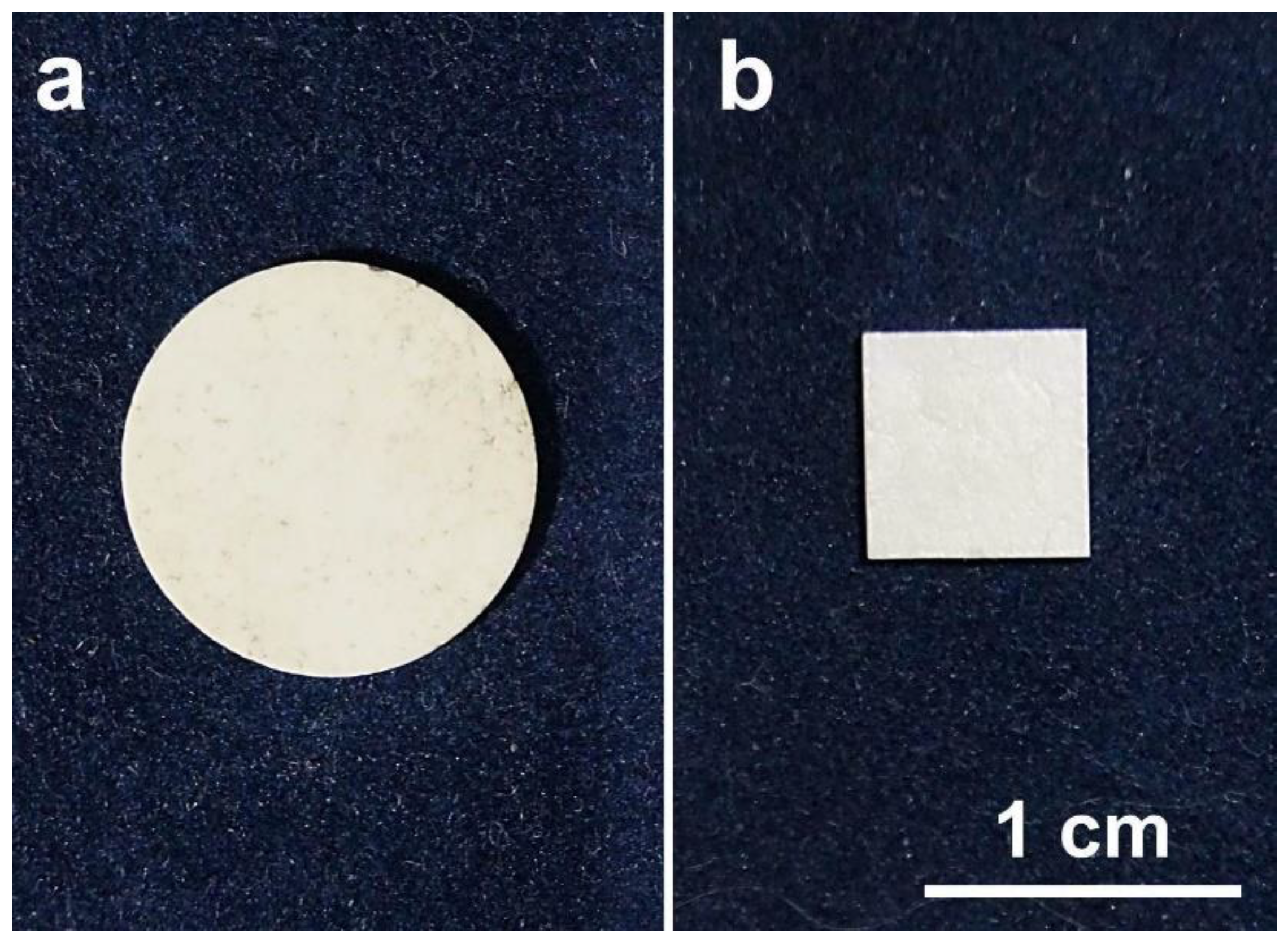
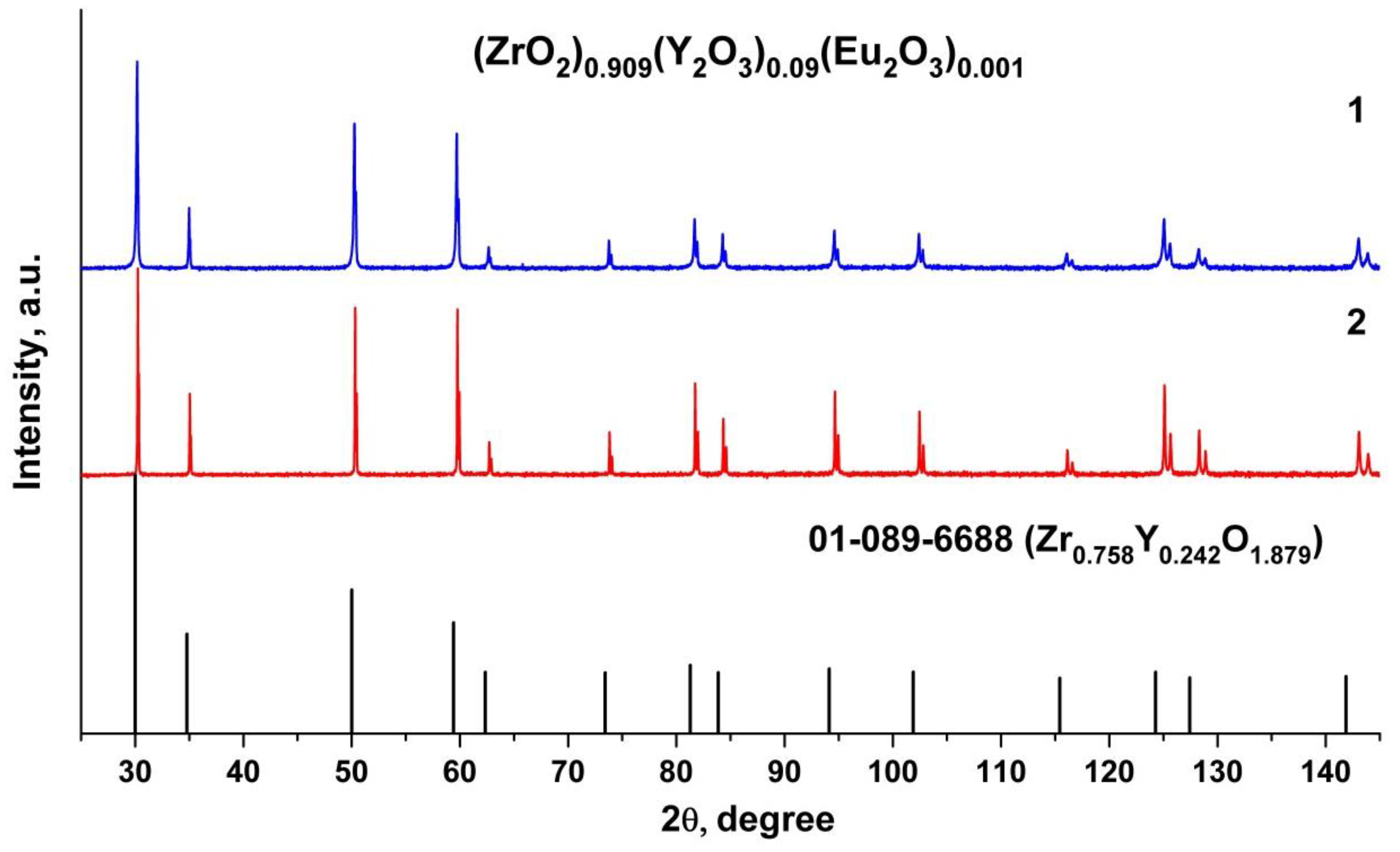
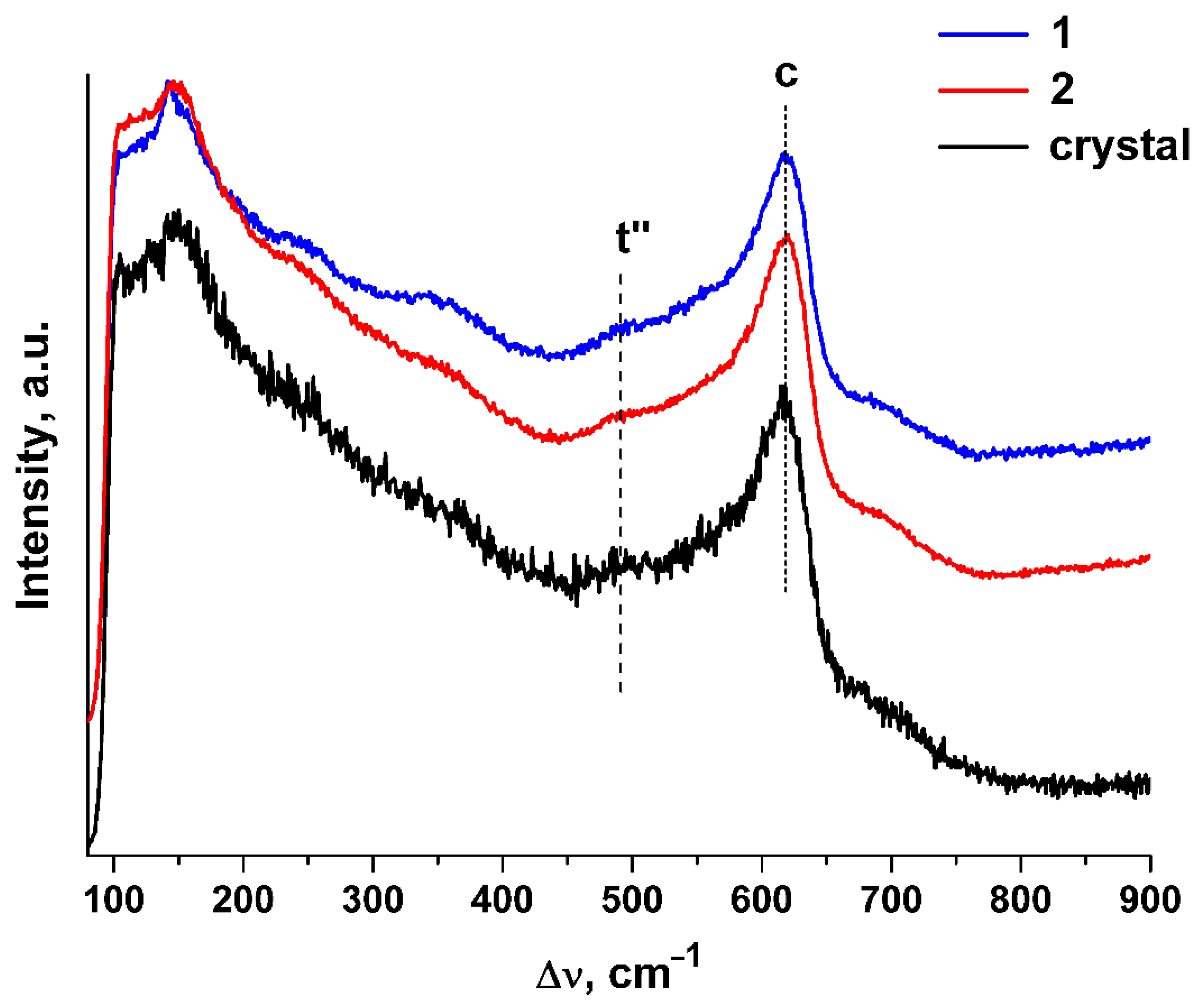
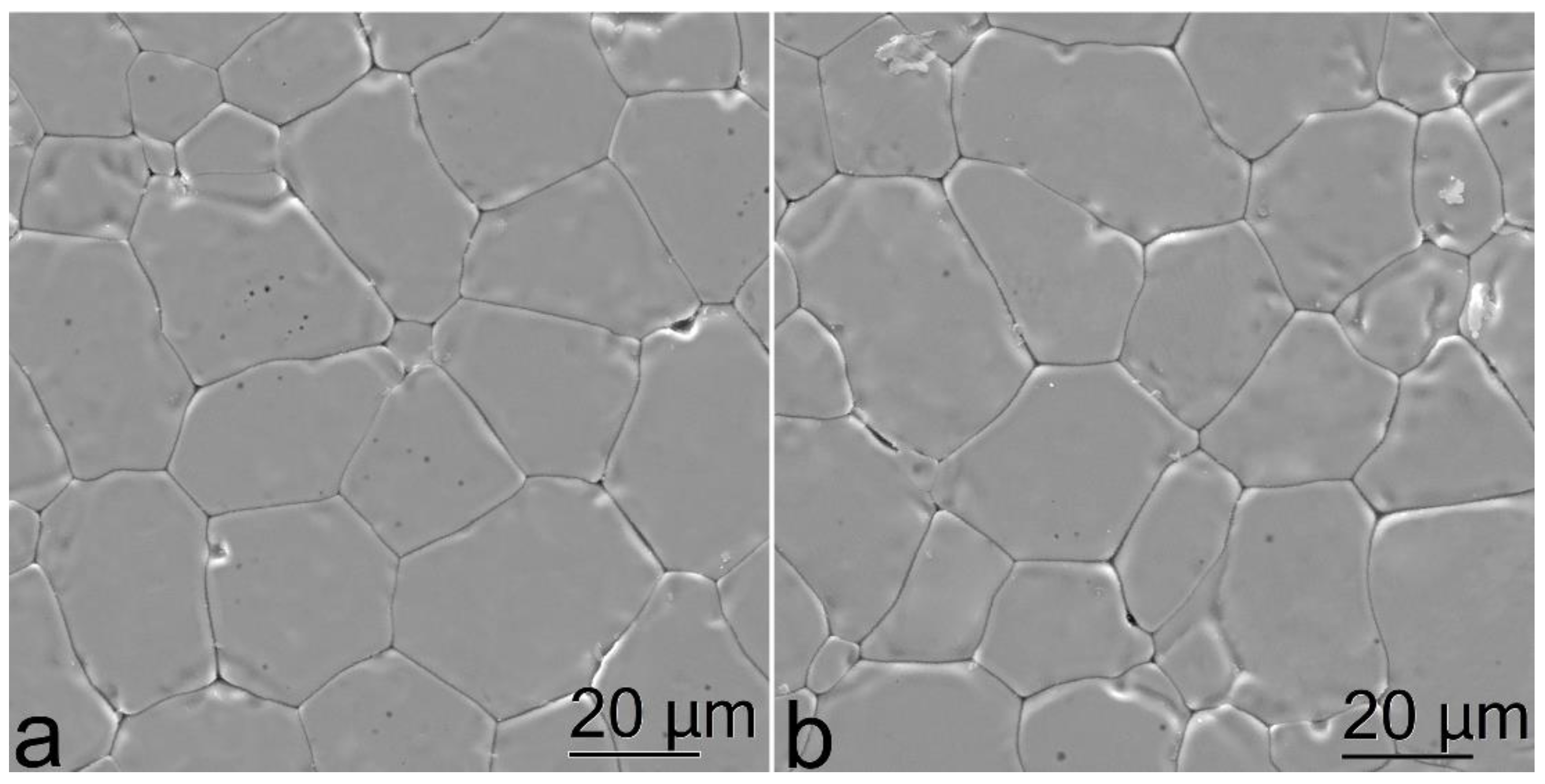
 symbols show areas (1, 2, 3, 4) in which the ZrO2, Y2O3 and Al2O3 oxide concentrations were measured.
symbols show areas (1, 2, 3, 4) in which the ZrO2, Y2O3 and Al2O3 oxide concentrations were measured.
 symbols show areas (1, 2, 3, 4) in which the ZrO2, Y2O3 and Al2O3 oxide concentrations were measured.
symbols show areas (1, 2, 3, 4) in which the ZrO2, Y2O3 and Al2O3 oxide concentrations were measured.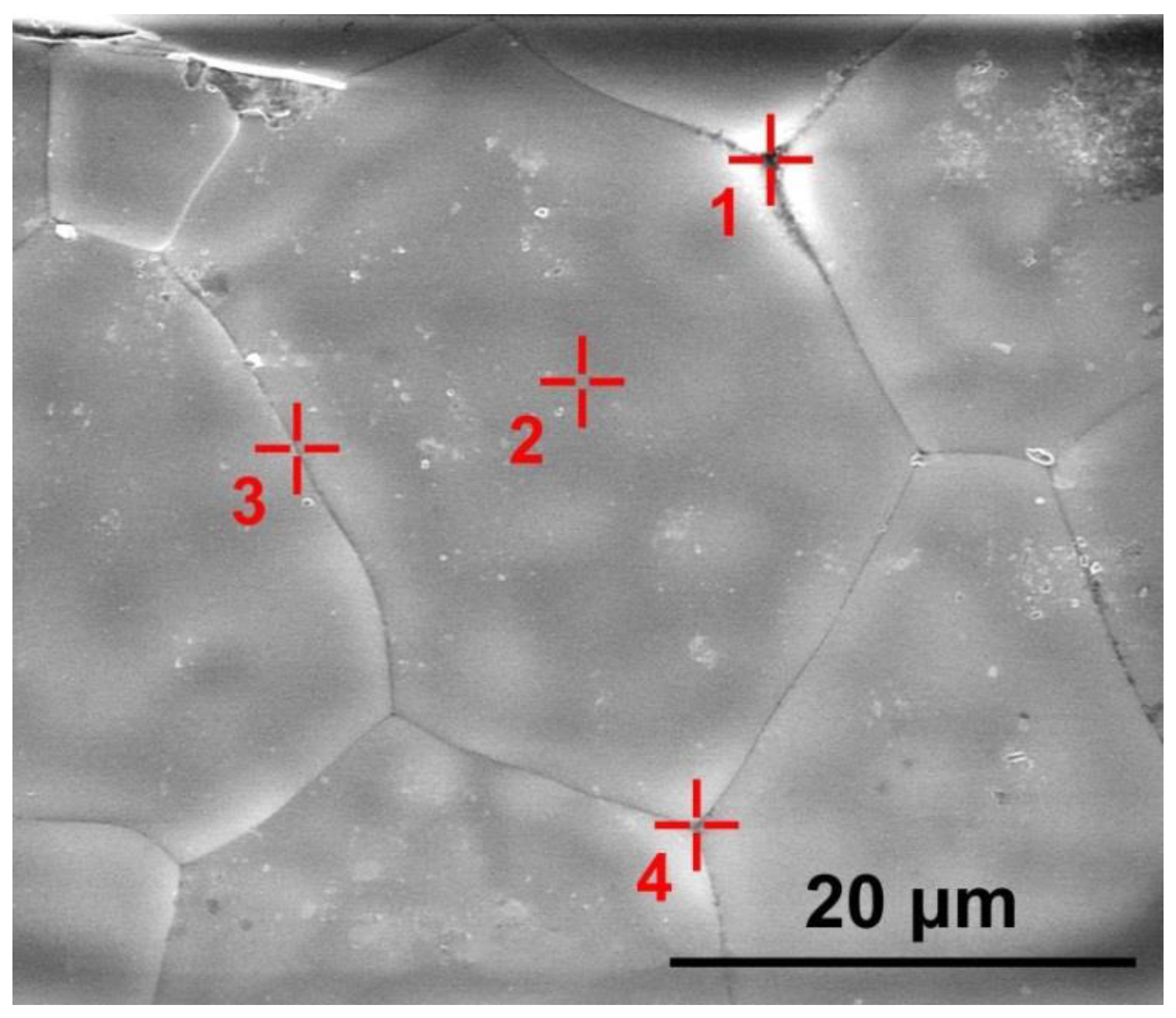
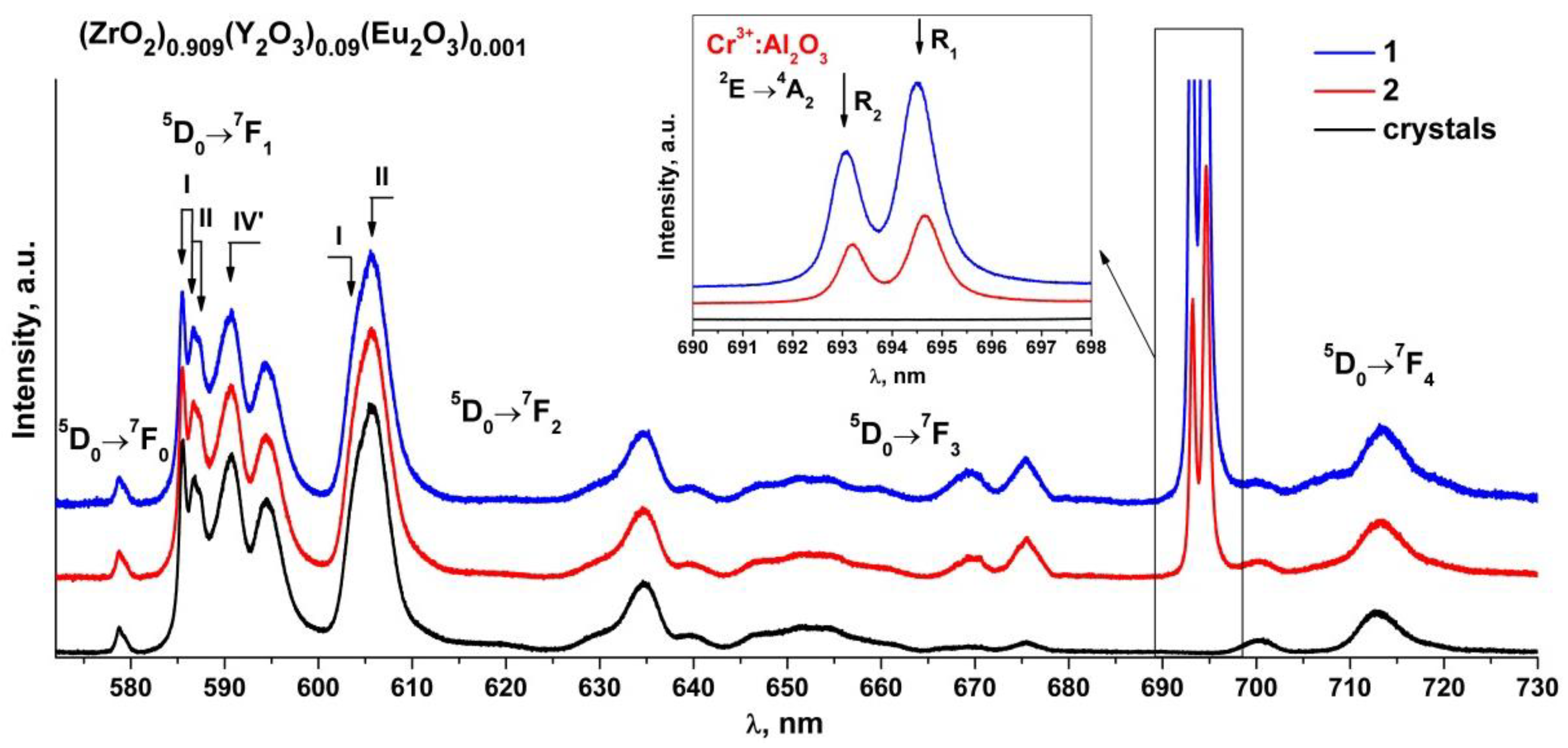
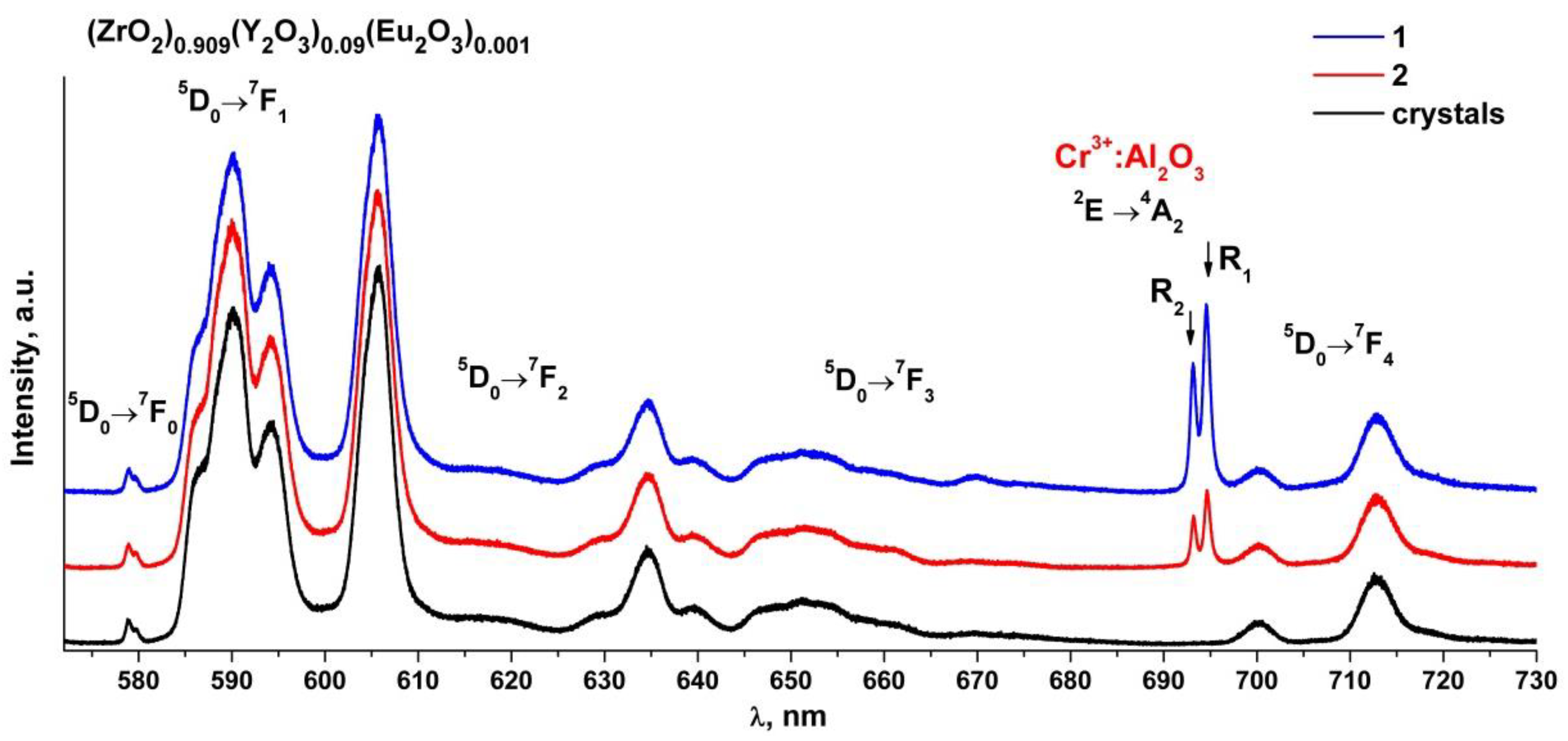
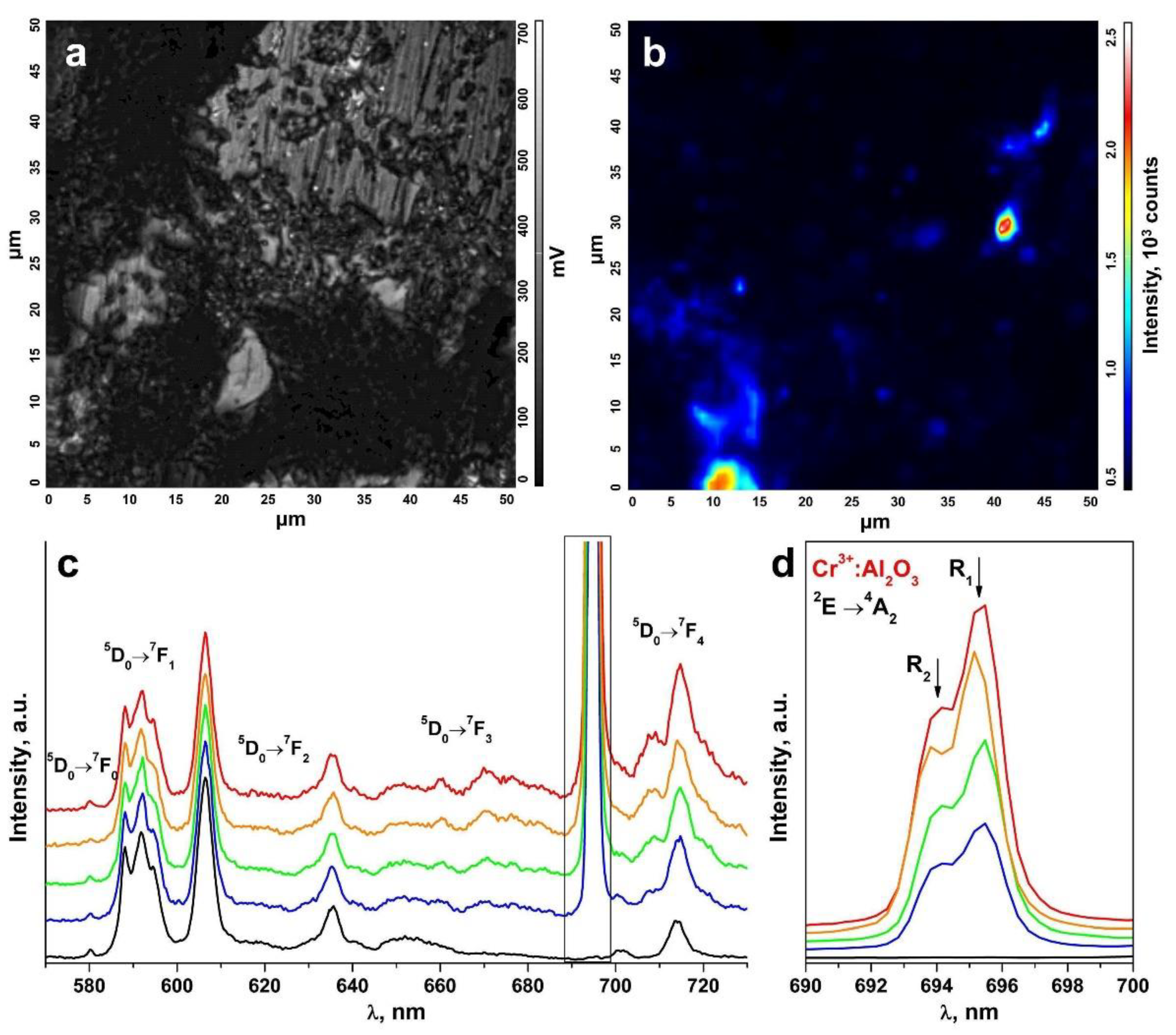

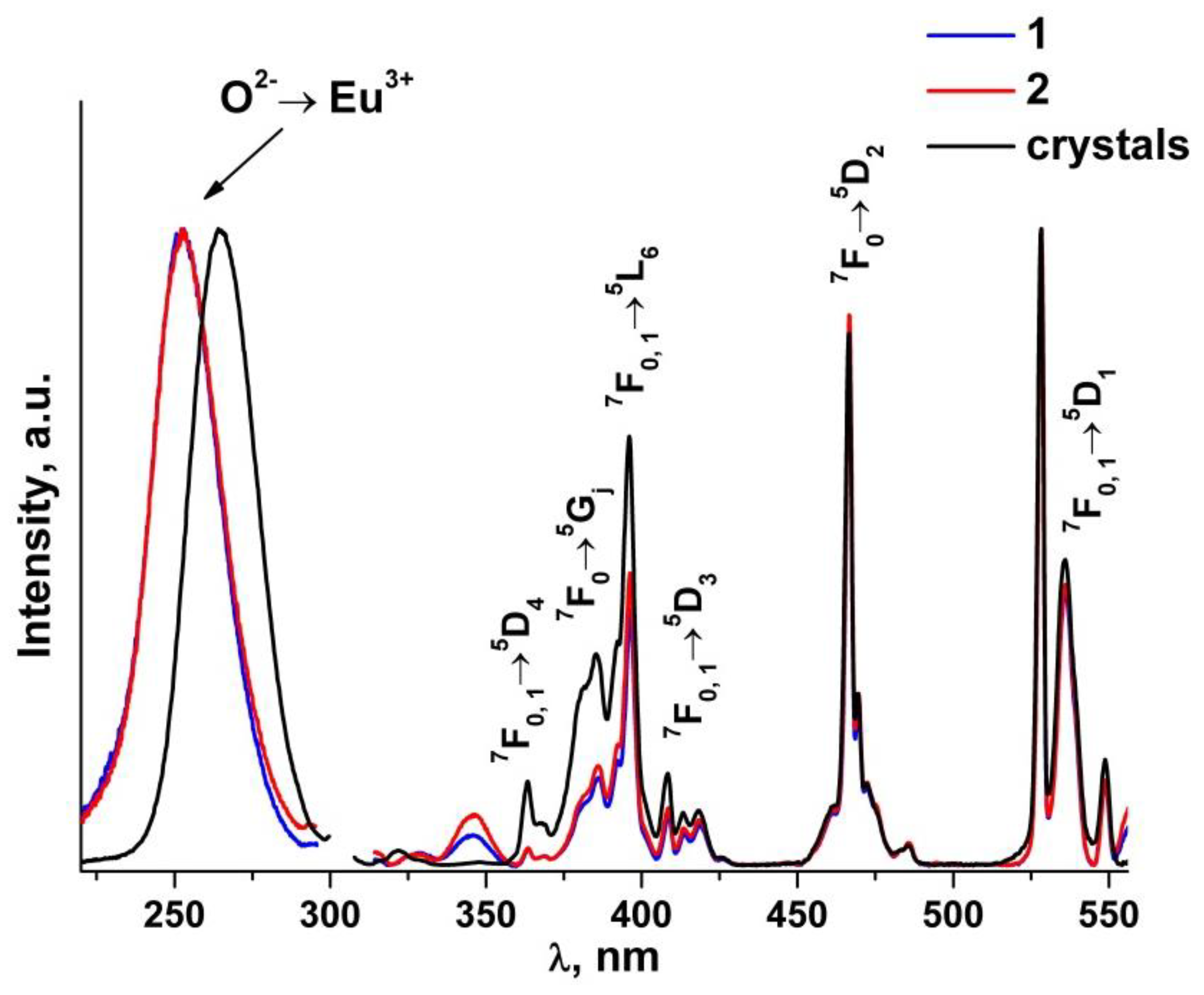
| (ZrO2)0.909(Y2O3)0.09(Eu2O3)0.001 Solid Solution | Phase Composition 1 | Space Group | Unit Cell Parameters |
|---|---|---|---|
| a, Å | |||
| Single Crystal | c-ZrO2 | Fm3m | 5.141(1) [17] |
| Ceramic #1 (Uniaxial Compaction) | c-ZrO2 | Fm3m | 5.1381(3) |
| Ceramic #2 (Slip Casting) | c-ZrO2 | Fm3m | 5.1368(3) |
| Area | Concentration, mol.% | ||
|---|---|---|---|
| ZrO2 | Y2O3 | Al2O3 | |
| 1 | 87.1 | 9.6 | 3.3 |
| 2 | 89.6 | 9.9 | 0.6 |
| 3 | 89.2 | 10.0 | 0.8 |
| 4 | 89.2 | 9.9 | 0.9 |
Publisher’s Note: MDPI stays neutral with regard to jurisdictional claims in published maps and institutional affiliations. |
© 2022 by the authors. Licensee MDPI, Basel, Switzerland. This article is an open access article distributed under the terms and conditions of the Creative Commons Attribution (CC BY) license (https://creativecommons.org/licenses/by/4.0/).
Share and Cite
Borik, M.; Kulebyakin, A.; Kyashkin, V.; Larina, N.; Lomonova, E.; Milovich, F.; Myzina, V.; Nezhdanov, A.; Ryabochkina, P.; Tabachkova, N.; et al. Structure and Spectral Luminescence Properties of (ZrO2)0.909(Y2O3)0.09(Eu2O3)0.001 Ceramics Synthesized by Uniaxial Compaction and Slip Casting. Materials 2022, 15, 7722. https://doi.org/10.3390/ma15217722
Borik M, Kulebyakin A, Kyashkin V, Larina N, Lomonova E, Milovich F, Myzina V, Nezhdanov A, Ryabochkina P, Tabachkova N, et al. Structure and Spectral Luminescence Properties of (ZrO2)0.909(Y2O3)0.09(Eu2O3)0.001 Ceramics Synthesized by Uniaxial Compaction and Slip Casting. Materials. 2022; 15(21):7722. https://doi.org/10.3390/ma15217722
Chicago/Turabian StyleBorik, Mikhail, Alexey Kulebyakin, Vladimir Kyashkin, Nataliya Larina, Elena Lomonova, Filipp Milovich, Valentina Myzina, Alexey Nezhdanov, Polina Ryabochkina, Nataliya Tabachkova, and et al. 2022. "Structure and Spectral Luminescence Properties of (ZrO2)0.909(Y2O3)0.09(Eu2O3)0.001 Ceramics Synthesized by Uniaxial Compaction and Slip Casting" Materials 15, no. 21: 7722. https://doi.org/10.3390/ma15217722
APA StyleBorik, M., Kulebyakin, A., Kyashkin, V., Larina, N., Lomonova, E., Milovich, F., Myzina, V., Nezhdanov, A., Ryabochkina, P., Tabachkova, N., & Chernov, E. (2022). Structure and Spectral Luminescence Properties of (ZrO2)0.909(Y2O3)0.09(Eu2O3)0.001 Ceramics Synthesized by Uniaxial Compaction and Slip Casting. Materials, 15(21), 7722. https://doi.org/10.3390/ma15217722








